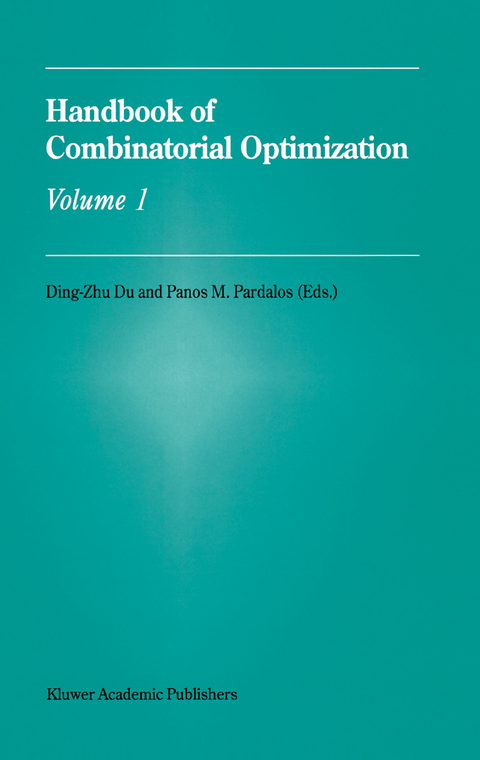
Handbook of Combinatorial Optimization
Springer (Verlag)
978-0-7923-5019-4 (ISBN)
Combinatorial (or discrete) optimization is one of the most active fields in the interface of operations research, computer science, and applied math ematics. Combinatorial optimization problems arise in various applications, including communications network design, VLSI design, machine vision, air line crew scheduling, corporate planning, computer-aided design and man ufacturing, database query design, cellular telephone frequency assignment, constraint directed reasoning, and computational biology. Furthermore, combinatorial optimization problems occur in many diverse areas such as linear and integer programming, graph theory, artificial intelligence, and number theory. All these problems, when formulated mathematically as the minimization or maximization of a certain function defined on some domain, have a commonality of discreteness. Historically, combinatorial optimization starts with linear programming. Linear programming has an entire range of important applications including production planning and distribution, personnel assignment, finance, alloca tion of economic resources, circuit simulation, and control systems. Leonid Kantorovich and Tjalling Koopmans received the Nobel Prize (1975) for their work on the optimal allocation of resources. Two important discover ies, the ellipsoid method (1979) and interior point approaches (1984) both provide polynomial time algorithms for linear programming. These algo rithms have had a profound effect in combinatorial optimization. Many polynomial-time solvable combinatorial optimization problems are special cases of linear programming (e.g. matching and maximum flow). In addi tion, linear programming relaxations are often the basis for many approxi mation algorithms for solving NP-hard problems (e.g. dualheuristics).
Mixed-Integer Nonlinear Optimization in Process Synthesis.- Approximate Algorithms and Heuristics for MAX-SAT.- Connections between Nonlinear Programming and Discrete Optimization.- Interior Point Methods for Combinatorial Optimization.- Knapsack Problems.- Fractional Combinatorial Optimization.- Reformulation-Linearization Techniques for Discrete Optimization Problems.- Gröbner Bases in Integer Programming.- Applications of Set Covering, Set Packing and Set Partitioning Models: A Survey.- Efficient Algorithms for Geometric Shortest Path Query Problems.- Computing Distances between Evolutionary Trees.- Combinatorial Optimization and Coalition Games.- Steiner Minimal Trees: An Introduction, Parallel Computation, and Future Work.- Resource Allocation Problems.- Combinatoral Optimization in Clustering.- The Graph Coloring Problem: A Bibliographic Survey.- Steiner Minimal Trees in E3: Theory, Algorithms, and Applications.- Dynamical System Approaches to Combinatorial Optimization.- On-line Dominating Set Problems for Graphs.- Optimization Problems in Optical Networks.- Shortest Networks on Surfaces.- Minimum Weight Triangulations.- Optimization Applications in the Airline Industry.- Semidefinite Relaxations, Multivariate Normal Distributions, and Order Statistics.- A Review of Machine Scheduling: Complexity, Algorithms and Approximability.- Routing and Topology Embedding in Lightwave Networks.- The Quadratic Assignment Problem.- Algorithmic Aspects of Domination in Graphs.- Selected Algorithmic Techniques for Parallel Optimization.- Multispace Search for Combinatorial Optimization.- The Equitable Coloring of Graphs.- Randomized Parallel Algorithms for Combinatorial Optimization.- Tabu Search.- Author Index.- Author Index.- Author Index.- Author Index of Volumes 1–3.-Subject Index of Volumes 1–3.
| Zusatzinfo | 36 Illustrations, black and white; XXIV, 2406 p. 36 illus. In 3 volumes, not available separately. |
|---|---|
| Verlagsort | Dordrecht |
| Sprache | englisch |
| Maße | 155 x 235 mm |
| Themenwelt | Mathematik / Informatik ► Informatik ► Theorie / Studium |
| Mathematik / Informatik ► Mathematik ► Graphentheorie | |
| Mathematik / Informatik ► Mathematik ► Wahrscheinlichkeit / Kombinatorik | |
| ISBN-10 | 0-7923-5019-7 / 0792350197 |
| ISBN-13 | 978-0-7923-5019-4 / 9780792350194 |
| Zustand | Neuware |
| Haben Sie eine Frage zum Produkt? |
aus dem Bereich


